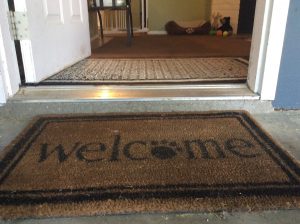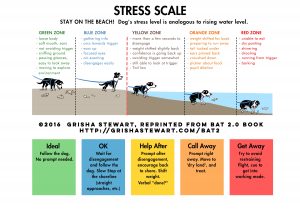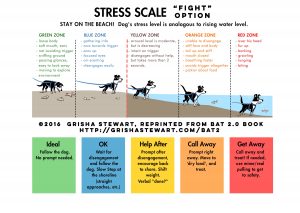
Dog guest’s view of my entry way.
Behavior Adjustment Training (BAT) was developed to socialize and rehabilitate dogs who are aggressive, fearful, or frustrated towards living creatures, typically dogs or humans.
I’ve been applying BAT principles during my Meet & Greet sessions at Solo Dogs, my special needs dog boarding business. I wanted to share some of these principles on how to help your dog get used to a new environment. This may come in handy if you board your dog at a person’s house, or even just bring them over to visit a friend.
First off, I want to stress that in any BAT set-up, the environment MUST be safe and arranged to maximize the dog’s changes of success. If a dog is put into a novel home environment, do a safety check: are any objects that the dog may knock over or damage stowed away? If the dog is to be let out in the yard, is the yard secured with a 6 foot fence on all sides and a locked gate? (This is tall enough for most dogs, but not all, so check with the dog’s owner to make sure this will contain your dog. Same for gaps under the fence for small dogs). If any objects are near the fence, that would effectively reduce fence height, take these into consideration. Close doors to rooms that the dog doesn’t need access to. Empty or hide trash bins. Remove all food items from counter tops. Make sure the environment is safe for the dog to freely roam about before the dog guest arrives.
Here are some of the BAT principles I follow during my boarding Meet & Greet:
Set An Example: Dogs are constantly reading the behavior of their humans. I want owners to be projecting a relaxed and confident attitude. I ask my clients to come into the house before me, and to behave as if this is their house. I wait until the clients and their dogs are inside before coming inside and immediately sitting down. When we are ready to both sit down on the couch, I ask that clients lean back and try to relax, and remember to breathe. Chatting also provides social modeling, setting an example for the dog. If your dog is very shy and doesn’t explore on his/her own, I may ask that you do the exploring around the house or yard, with the dog following.
Free To Move: BAT makes use of a long leash and specific leash-handling skills to allow the dog as much freedom to roam without feeling trapped or constrained. I ask visitors to unleash their dogs immediately upon entering the house. A new home that has the scent of unfamiliar dogs causes a great deal of excitement. Dog-reactive dogs will need to quickly ascertain whether there’s another dog in the home and they will generally move much faster than you can walk when they’re doing this scan. Most clients leave the harness on, if the dog is wearing one. You could certainly let a dog drag a leash around the house, although this becomes tricky in navigating chairs, tables or other objects that the leash may get tangled around.
Few Distractions: It’s vital in BAT that the dog be allowed to learn about the environment and not be in “play” or “train” mode. It is for this reason that I don’t give dogs treats or toys to distract them or attempt to engage them until the dog has displayed a willingness to lay down and relax. I may offer toys, but in general, I want the dog’s attention focused on the environment as much as possible. If clients bring children to the meet and greet, it makes it a little more difficult because they tend to want to interact with the dog.
Minimal Interference From Humans: In BAT the goal is to only attempt to move the dog away from the trigger to prevent over arousal. In my situation, this may come in the form of a dog walking down the street that is on the boundary of my yard or a neighbor’s dog barking. Following the BAT guidelines, it’s vital to quickly assess the dog’s stress level, and when necessary, either call the dog into the house and reward, or physically bring the dog inside and reward. If the dog doesn’t have a good recall, you may want to let the dog drag a leash around while in a yard. Grisha’s BAT 2.0 book has great illustrations and describes 5 stress zones, with body language and the recommended human intervention (thanks to Grisha for letting me use her images):
The Dog Sets The Pace: How long does it take for a dog to relax in a new environment? Usually it’s between 1-2 hours, and so I make sure clients are prepared to stay for at least that long. If after that time the dog isn’t relaxed (laying down with head down) then we’ll simply schedule another Meet & Greet session. Just like in BAT, the dog sets the pace of learning and multiple sessions are part of the plan.
Allow Maximum Learning: There are rooms to my home that I don’t want new dogs to have full access to. If it is a room that I want the dog to learn about because they will be spending time inside it, such as my bedroom, I’ll put up a baby gate, so that the dog can look inside and smell. The more information you can allow the dog to gather on his/her own, the less they will be surprised and startled by some novelty they didn’t know was there.
Observe Dog’s Behaviors During 2nd Visit: It’s very important my prospective clients pay close attention to the dog as they approach my house for their second visit. Following Grisha’s “empowered animals” philosophy, it’s important to me that the dog willingly comes back into my home. The decision about whether a dog client is a good match for boarding, is made by three beings: me, the prospective client, and the dog.
LEARN MORE ABOUT BAT: If you’re in the Seattle area, you can enroll in a Growly Dog Class by Ahimsa Dog Training or you can learn more about BAT 2.0 online.


